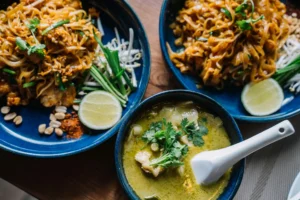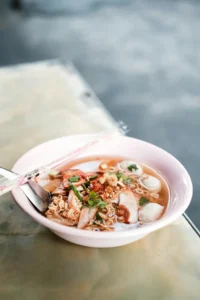Whether you are an avid lover of Asian food or simply exploring new things, one dish you have probably heard of and would like to at least taste is Pad Thai- a world-renowned Thai stir-fried noodle dish that is not only savory, but filled with deliciousness. In the local restaurants or a food truck, and even when viewing Thai delivery apps, one may notice a special Pad Thai menu.
So,o just what does one find in a Pad Thai menu? In this guide, we will take you through the basics of Thai food, including popular dishes, ingredients, variations, and dos and don’ts of ordering, as well as how to make the most of your Thai food experiences.
What Is Pad Thai?
Pad Thai is the national dish of Thailand and one of the most renowned dishes in Thai cuisine. It is normally made of stir-fried rice noodles, scrambled eggs, bean sprouts, peanuts, and a sweet, sour, and savory type of sauce using tamarind, fish sauce, and sugar. It is usually prepared with your preferred protein, which can be chicken, shrimp, tofu, or beef, in is adorned using lime wedges and crushed peanuts.
Pad Thai has a secret, and this secret is that the tastes of the dish are balanced (salty, sweet, sour, and umami), which results in a mouthwatering noodle dish impossible to resist.
What’s Typically on a Pad Thai Menu?

Although Pad Thai can be considered a symbol of a particular dish, there is also a whole Pad Thai menu in most restaurants that could have some variations according to tastes and dietary requirements.
Here are the most common options you’ll find:
1. Classic Chicken Pad Thai
- The most popular variation.
- Made with tender chicken breast slices, egg, rice noodles, and classic Pad Thai sauce.
- Often garnished with bean sprouts, green onions, and crushed peanuts.
2. Shrimp Pad Thai (Pad Thai Goong)
- A seafood lover’s favorite.
- Features succulent shrimp, sometimes with added squid or scallops.
- Best enjoyed with a squeeze of lime and a dash of chili flakes.
3. Vegetarian Pad Thai
- Perfect for plant-based eaters.
- Includes tofu or mock meat instead of animal proteins.
- Sauce may be vegan-friendly, but always ask if it contains fish sauce.
4. Tofu Pad Thai
- Often includes deep-fried tofu cubes, offering a crispy texture.
- Full of plant-based protein.
- Ideal for vegetarians and those looking for a lighter option.
5. Beef or Pork Pad Thai
- Less common but still available at some places.
- Offers a heartier and richer flavor profile.
- Pairs well with extra vegetables like carrots and bell peppers.
6. Spicy Pad Thai
- For those who love heat!
- Same base as classic Pad Thai but with added chili or Thai hot sauce.
- Can be customized for medium or Thai-level spice.
Common Ingredients Found in Pad Thai Dishes

While variations exist, most Pad Thai dishes contain these key ingredients:
| Ingredient | Purpose |
| Rice noodles | Base of the dish; chewy and satisfying |
| Eggs | Adds richness and protein |
| Tofu or Meat | Main protein source |
| Bean sprouts | Freshness and crunch |
| Crushed peanuts | Texture and nutty flavor |
| Tamarind paste | Sourness and depth |
| Fish sauce | Saltiness and umami |
| Palm sugar | Sweetness balance |
| Lime wedges | Fresh sour flavor for the final touch |
| Garlic & shallots | Aromatics to enhance flavor |
Pad Thai Menu: Nutritional Insights
If you’re health-conscious, here’s what you should know:
- Calories: Ranges from 300 to 600+ per serving, depending on the protein and oil used.
- Protein: Chicken or tofu options offer great protein content (15g–25g per serving).
- Gluten-Free: Most rice noodles are gluten-free, but check the sauce ingredients to be sure.
- Vegan Options: Ask for no egg, no fish sauce, and tofu instead of meat.
Best Side Dishes with Pad Thai
To create a balanced Thai meal, pair your Pad Thai with:
- Thai Spring Rolls – Crispy and filled with veggies or shrimp.
- Tom Yum Soup – Spicy-sour broth with mushrooms and shrimp.
- Thai Papaya Salad (Som Tum) – Fresh and spicy salad that complements noodles.
- Sticky Rice with Mango – A sweet dessert to cool down the spice.
How to Order from a Pad Thai Menu
Whether you’re dining in, ordering online, or picking up takeout, follow these tips:
- Choose your protein wisely—chicken and shrimp are traditional favorites.
- Customize spice levels—many places allow you to choose from mild to Thai spicy.
- Ask about allergies, especially to peanuts, soy, or gluten.
- Add extras like more veggies or extra lime for a fresher twist.
- Try a combo meal—many restaurants offer Pad Thai with a drink and an appetizer.
Pad Thai Menu for Kids
Yes, Pad Thai is kid-friendly too! Many restaurants offer:
- Mild versions with no spice
- Egg-only or tofu Pad Thai
- Mini portions with sides like fruit or spring rolls
Pad Thai’s sweet and savory flavor often appeals to younger palates, especially when served without chili.
Exploring Pad Thai Beyond Restaurants
Love Pad Thai and want to try making it at home?
Here’s a simple homemade Pad Thai kit checklist:
- Rice noodles
- Tamarind paste or sauce
- Fish sauce (or soy sauce for vegetarians)
- Brown or palm sugar
- Lime
- Garlic and onion
- Peanuts
- Protein (tofu, shrimp, or chicken)
Many Asian grocery stores or online retailers now sell Pad Thai kits for convenience. It’s a fun way to enjoy the dish while customizing it exactly how you like it.
Final Thoughts: Why the Pad Thai Menu Never Disappoints
The Pad Thai menu has something to cater to all those who like Thai food and also to first-time customers. Having a blend of strong flavors, an array of ingredients, and the versatility of customizing each recipe, it is not hard to see why Pad Thai has been one of the most common takeout, dine-in, or home-cooked meals.
Next time you are browsing through a Thai food menu, do not worry about trying the new and exciting dishes or spending some quality time on your old favorite. Whether it is fish cakes to chicken, spicy or mild, the Pad Thai menu has been able to cater to your cravings.
FAQs about the Pad Thai Menu
Q1: Is Pad Thai spicy?
Not always. Most places let you choose the spice level, from mild to Thai spicy.
Q2: Can Pad Thai be made vegan?
Yes, just ask for no egg, no fish sauce, and use tofu or vegetables as protein.
Q3: What’s the best protein option in Pad Thai?
Shrimp and chicken are the most popular, but tofu is great for vegetarians.
Q4: How long does Pad Thai last in the fridge?
2–3 days in an airtight container. Reheat with a splash of water to restore texture.
Want more foodie guides like this? Explore more delicious reads on clogtheblog.com — your destination for mouthwatering menus, travel finds, and trending bites!

